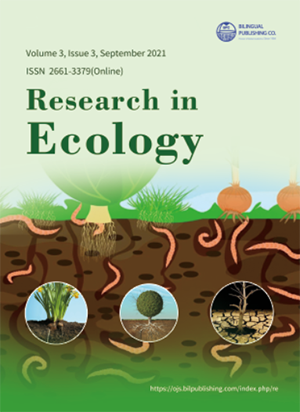
Biodiversity-friendly Agricultural Practices in the Indigenous Agricultural Systems in the Biodiversity Corridor of the Alto Paraná Atlantic Forest (Paraguay)
DOI:
https://doi.org/10.30564/re.v3i3.3358Abstract
Agricultural systems result of the coevolution between social and natural systems, where biodiversity and natural resources play an important role, emerging interactions between crops and the natural environment that allow the development of ecological processes which interact with external inputs. This research aims to describe the agricultural practices developed by the Guarani Indigenous people in the agricultural systems located within the biodiversity corridor of the Upper Parana Atlantic Forest. This exploratory study is focused on multiple cases, with a qualitative approach and from data collected during 2017 and 2018 in eleven indigenous communities. The main practices developed for the management of biodiversity are polyculture, rotation, and embroideries; they also practice agroforestry and livestock-raising. The main difficulty they face is the reduction of the surrounding biodiversity, which affects the sustainability of the system. This study shows ways for nature-based solutions and ecosystem-based adaptation according to current needs for greening the economy.
Keywords:
Indigenous agriculture, Agrobiodiversity, Slash-and-burn, Nature based solutions, Ecosystem based adaptationReferences
[1] Altieri, M. (1999). Agroecología, Bases científicas para una agricultura sustentable (3th ed.). Editorial Nordan–Comunidad. http://agroeco.org/wp-content/uploads/2010/10/Libro-Agroecologia.pdf
[2] Stupino, S., Lermanó, M., Gargoloff, N. and Bonicatto, M. (2014). La biodiversidad en los agroecosistemas. En Agroecología: Bases teóricas para el diseño manejo de Agroecosistemas (pp. 131-158). Universidad Nacional de la Plata.
[3] Rosset, P., and Altieri, M. (2018). Agroecología, ciencia y política (A. Porras, Trad.; 3ra ed.). SOCLA
[4] Mateos-Maces, L., Castillo-González, F., Servia, J. L. C., Estrada-Gómez, J. A., and Livera-Muñoz, M. (2016). Manejo y aprovechamiento de la agrobiodiversidad en el sistema milpa del sureste de México. Acta Agronómica, 65(4), 413-421.
[5] Mereles, M. F.; Céspedes, G.; Cartes, J.L.; Goerzen, R; De Egea-Elsam, J.; Rodriguez, L.; Yanosky, A.; Villalba, L.; Weiler, A. and Cacciali, P. (2020). Biological Corridors as a Connectivity Tool in the Region of the Great American Chaco: Identification of Biodiversity Hotspots in the Ecoregions of the Paraguayan Chaco. Research in Ecology 2(1): 27-36. DOI: https://doi.org/10.30564/re.v2i1.1324
[6] Esquivel M., A.; Tiffer-Sotomayor, R.; Díaz, A., Centrón, S., Bartrina, L.; Ruíz, R., Clay, R. P., del Castillo, H. and Yanosky, A. (2018). The avifauna of Ypetĩ Nature Reserve, and its implication for the consolidation of the Atlantic Forest Corridor in Paraguay. The Wilson Journal of Ornithology: https://doi.org/10.1676/18-52.1
[7] WWF and FVSA (Fundación Vida Silvestre Argentina). (2020). Lessons Learnt from 16 years of Restoring the Atlantic Forest at a Trinational Level: the Upper Paraná in Argentina, Brazil and Paraguay. https://wwfint.awsassets.panda.org/downloads/flr_field_series_atlantic_forest.pdf
[8] Amarilla R., S. M.; Yanosky, A. and Villalba, J. (2019). San Rafael Reserve, Paraguay: Key social stakeholders and sustainability scenarios through environmental governance approaches. In: Delgado L.E. & Marín V. H. (eds.), Social-ecological systems of Latin America: complexities and challenges. Springer Nature Switzerland, pp. 229-246
[9] Nogaard, R. and Sikor, T. (1999). Metología y práctica de la agroecología. En Agroecología: Bases científicas para una agricultura sustentable (4ta ed., pp. 31-46). Editorial Nordan–Comunidad.
[10] Glauser, M. (2010). Desculturación y regeneración cultural: Aportes del sistema alimentario y agroecológico Paî-Tavyterâ. Base IS. http://biblioteca.clacso.edu.ar/Paraguay/base-is/20170403025933/pdf_1244.pdf
[11] Lehner, B. (2005). Los pueblos Guarani del Paraguay Oriental. MISEREOR.
[12] Ladeira, M. and Ariovaldo, U. (2008). Espaço geográfico Guarani-MBYA: significado, constituição e uso. Rever, 20(2). https://www.researchgate.net/publication/34738100_Espaco_geografico_Guarani-MBYA_significado_constituicao_e_uso
[13] Leal Filho, A. F. W. and Azeiteiro, U. (Eds.). (2018). Theory and practice of climate adaptation (Ser. Climate change management). Springer. https://doi.org/10.1007/978-3-319-72874-2
[14] Dirección General de Estadísticas, Encuestas y Censos. (2015). Familia lingüística Guaraní: Vol. Atlas de Comunidades de Pueblos Indígenas den Paraguay 2012.
[15] Gliessman, S. R. (2002). Agroecología: Procesos ecológicos en agricultura sostenible. Centro Agronómico Tropical de Investigación y Enseñanza.
[16] Vargas, F., Giménez, A., Lehner, B. and Florentin, A. (2012). Ñande kuaapy teete: Un rescate de saberes y tecnologías de la agricultura guarani. Fundación Acción Contra el Hambre.
[17] Lafortezza, R.; Chen, J.; Konijnendijk, C. van den Bosch and Randrup, T. B. (2018). Nature-based solutions for resilient landscapes and cities. Environmental Research 165 (2018): 431-441
[18] Renaud, F. G., Sudmeier-Rieux, K., Estrella, M. and Nehren, U. (2016). Ecosystem-based disaster risk reduction and adaptation in practice In: Advances in natural and technological hazards research, volume 42. Springer. https://doi.org/10.1007/978-3-319-43633-3
Downloads
How to Cite
Issue
Article Type
License
Copyright © 2021 Federico Vargas Lehner, Ruth Tiffer-Sotomayor, Alejandrino Díaz, Alberto Yanosky

This is an open access article under the Creative Commons Attribution-NonCommercial 4.0 International (CC BY-NC 4.0) License.




 Federico Vargas Lehner
Federico Vargas Lehner





